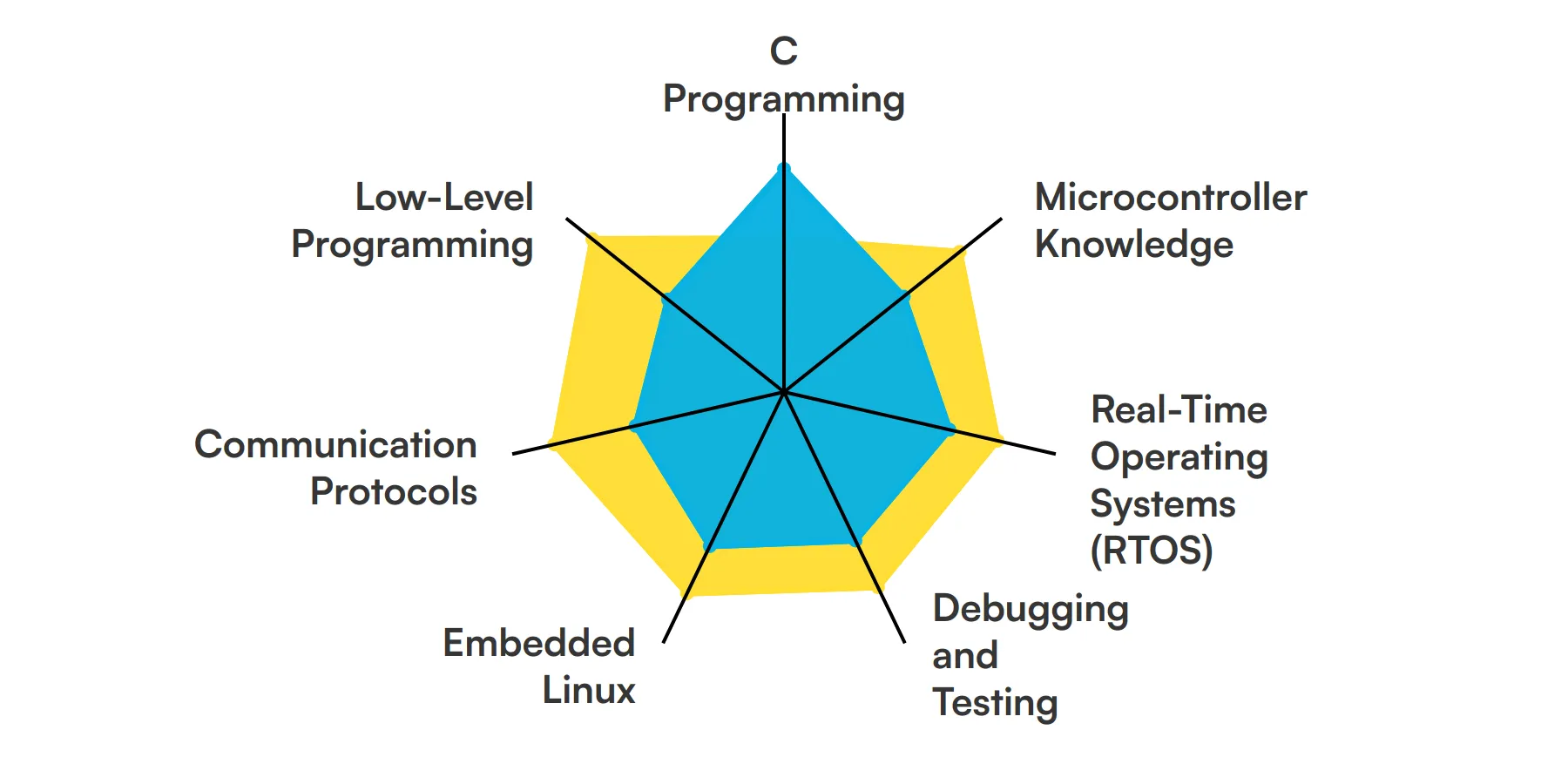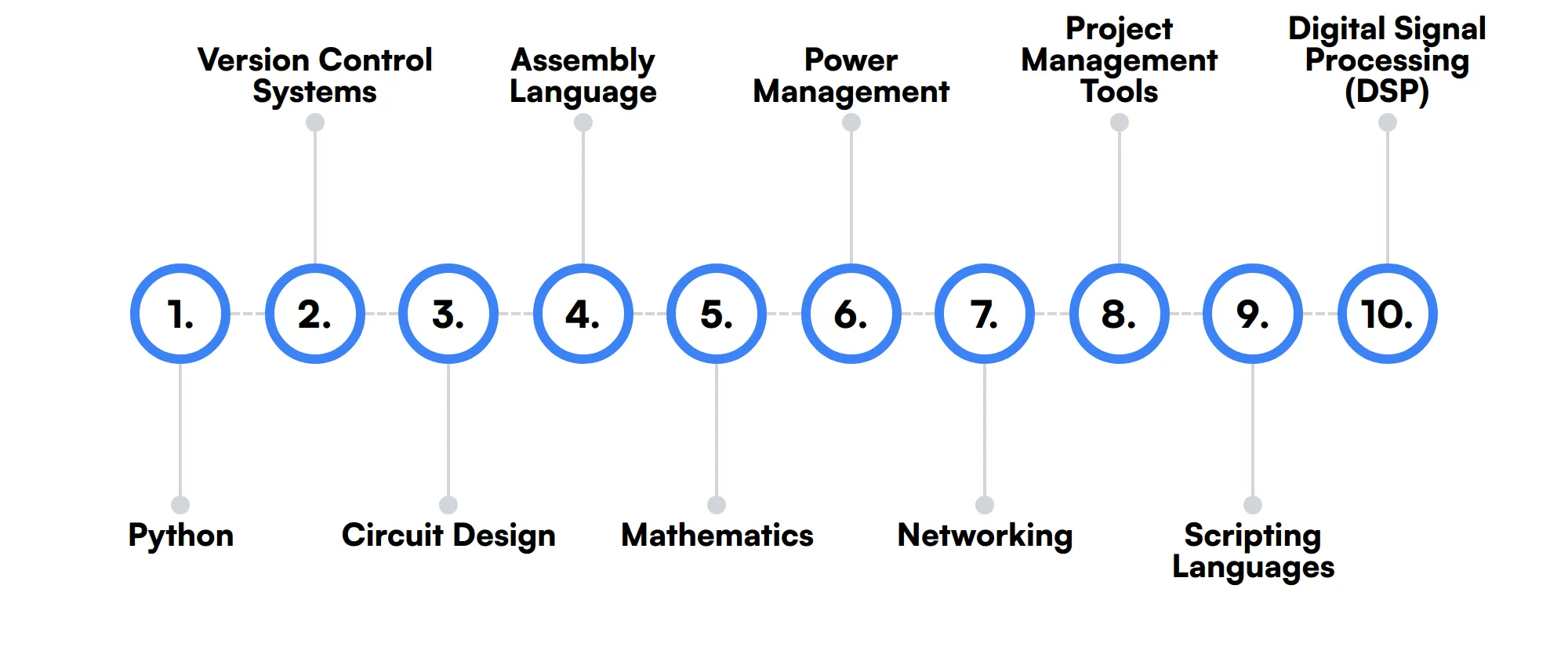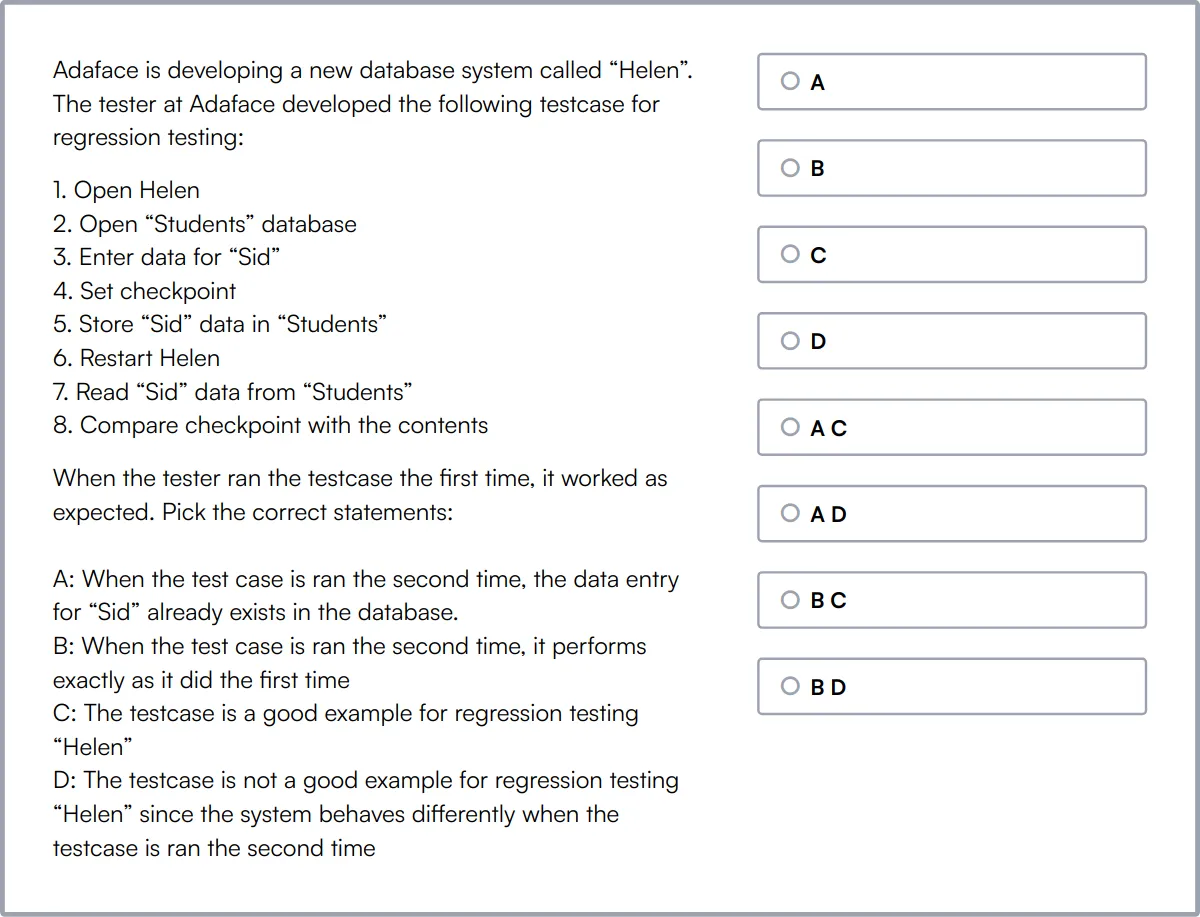Embedded software engineers are at the heart of creating the brains for devices that are integral to our daily lives. They ensure that hardware functions optimally with the software that controls it.
Skills necessary for this role include proficiency in programming languages like C and C++, understanding of microcontroller architectures, and abilities in problem-solving and system design.
Candidates can write these abilities in their resumes, but you can’t verify them without on-the-job Embedded Software Engineer skill tests.
In this post, we will explore 7 essential Embedded Software Engineer skills, 10 secondary skills and how to assess them so you can make informed hiring decisions.
Table of contents
7 fundamental Embedded Software Engineer skills and traits
The best skills for Embedded Software Engineers include C Programming, Microcontroller Knowledge, Real-Time Operating Systems (RTOS), Debugging and Testing, Embedded Linux, Communication Protocols and Low-Level Programming.
Let’s dive into the details by examining the 7 essential skills of a Embedded Software Engineer.

C Programming
C is the backbone of embedded systems. An embedded software engineer uses C to write efficient, low-level code that directly interacts with hardware. Mastery of C allows for precise control over system resources and performance.
Check out our guide for a comprehensive list of interview questions.
Microcontroller Knowledge
Understanding microcontrollers is key for embedded software engineers. They need to know how to program and interface with these small computing devices, which are the heart of most embedded systems. This includes familiarity with different architectures and peripherals.
Real-Time Operating Systems (RTOS)
RTOS knowledge is crucial for managing tasks in time-sensitive applications. An embedded software engineer uses RTOS to ensure that critical tasks are executed within strict timing constraints, which is essential for applications like automotive systems and medical devices.
For more insights, check out our guide to writing a Embedded Software Engineer Job Description.
Debugging and Testing
Debugging and testing skills are essential for identifying and fixing issues in embedded systems. Engineers use tools like oscilloscopes, logic analyzers, and software debuggers to troubleshoot hardware-software interactions and ensure system reliability.
Embedded Linux
Embedded Linux is widely used in complex embedded systems. Engineers need to be proficient in configuring and programming Linux-based systems, which includes understanding kernel modules, device drivers, and user-space applications.
Communication Protocols
Knowledge of communication protocols like I2C, SPI, UART, and CAN is essential. An embedded software engineer uses these protocols to enable different components of a system to communicate with each other, ensuring seamless data exchange.
Low-Level Programming
Low-level programming involves writing code that interacts directly with hardware. This skill is crucial for tasks like writing device drivers and managing memory, allowing the engineer to optimize system performance and resource usage.
10 secondary Embedded Software Engineer skills and traits
The best skills for Embedded Software Engineers include Python, Version Control Systems, Circuit Design, Assembly Language, Mathematics, Power Management, Networking, Project Management Tools, Scripting Languages and Digital Signal Processing (DSP).
Let’s dive into the details by examining the 10 secondary skills of a Embedded Software Engineer.

Python
Python is often used for scripting and automation tasks in embedded systems development. It can help in writing test scripts, automating build processes, and even in some high-level application development.
Version Control Systems
Proficiency with version control systems like Git is important for managing code changes and collaborating with team members. It helps in tracking revisions and maintaining a history of the codebase.
Circuit Design
Basic knowledge of circuit design can be beneficial. Understanding how circuits work helps in debugging hardware issues and designing better software that interacts with the hardware effectively.
Assembly Language
While not always required, knowledge of assembly language can be useful for optimizing performance-critical sections of code. It allows the engineer to write highly efficient code that runs directly on the processor.
Mathematics
Strong mathematical skills are often needed for developing algorithms, especially in areas like signal processing, control systems, and data analysis. This helps in creating efficient and accurate software solutions.
Power Management
Understanding power management techniques is important for designing energy-efficient embedded systems. This includes knowledge of low-power modes, power-saving algorithms, and hardware components that support power management.
Networking
Basic networking knowledge can be useful for embedded systems that need to communicate over networks. This includes understanding TCP/IP, wireless communication standards, and network security principles.
Project Management Tools
Familiarity with project management tools like JIRA or Trello can help in tracking project progress, managing tasks, and collaborating with team members. This ensures that projects stay on schedule and meet their goals.
Scripting Languages
Knowledge of scripting languages like Bash or Perl can be useful for automating repetitive tasks, managing system configurations, and performing quick data processing tasks.
Digital Signal Processing (DSP)
DSP skills are valuable for applications that involve audio, video, or other signal processing tasks. This includes understanding algorithms and techniques for filtering, transforming, and analyzing signals.
How to assess Embedded Software Engineer skills and traits
Assessing the skills and traits of an Embedded Software Engineer involves more than just glancing at a resume. It requires a deep understanding of the technical competencies and hands-on capabilities that are necessary for success in this specialized field. Knowing how to evaluate these skills effectively is key to identifying the right candidate for your projects.
Embedded Software Engineers need a solid grasp of C Programming, Microcontroller Knowledge, Real-Time Operating Systems (RTOS), Debugging and Testing, Embedded Linux, Communication Protocols, and Low-Level Programming. Each of these areas plays a critical role in their daily tasks and overall performance.
To streamline the hiring process and ensure a thorough evaluation, consider using specialized assessment tools. Adaface assessments offer a tailored approach to testing these key skills, helping you achieve a 2x improvement in the quality of your hires while significantly reducing the time spent screening candidates.
Let’s look at how to assess Embedded Software Engineer skills with these 4 talent assessments.
C Online Test
Our C Online Test evaluates candidates on their fundamental knowledge of C programming, covering a wide range of topics from basic syntax to complex file handling techniques.
The test assesses understanding of data types, control statements, functions, arrays, and pointers. It also challenges candidates with dynamic memory allocation and advanced concepts like preprocessor directives and macros.
Successful candidates demonstrate a thorough grasp of C programming essentials, including efficient use of pointers and structures, and the ability to manage memory and file systems effectively.

Embedded C Online Test
Our Embedded C Online Test is designed to evaluate a candidate's skills in developing C/Embedded C drivers and libraries, crucial for firmware development.
This test covers Embedded C basics, including I/O Hardware Addressing, bit operations, and the use of pointers with arrays, structures, and unions. It also evaluates knowledge of cross-compiling toolchains and compiler optimizations.
Candidates who excel in this test are proficient in applying object-oriented principles to Embedded C, optimizing code for performance, and debugging complex embedded systems.

Manual Testing Online Test
Our Manual Testing Online Test assesses a candidate's ability to manually execute test cases to identify defects in various software applications.
The test evaluates proficiency in test case writing, test plan development, and the management of test strategies and documentation. It also tests knowledge in specialized areas like mobile app testing and penetration testing.
High-scoring candidates are adept at designing effective test cases, managing detailed documentation, and identifying critical defects across different types of software.

Linux Online Test
Our Linux Online Test measures a candidate's proficiency in managing and operating the Linux environment, from basic commands to advanced system administration.
The test challenges candidates with Linux command line usage, file system management, process management, and networking. Security and shell scripting are also key areas assessed.
Candidates who perform well on this test demonstrate strong capabilities in Linux system troubleshooting, effective management of Linux servers, and scripting for automation and configuration.

Summary: The 7 key Embedded Software Engineer skills and how to test for them
| Embedded Software Engineer skill | How to assess them |
|---|---|
| 1. C Programming | Evaluate proficiency in writing and optimizing embedded C code. |
| 2. Microcontroller Knowledge | Test understanding of microcontroller architecture and interfacing. |
| 3. Real-Time Operating Systems (RTOS) | Assess ability to implement and manage RTOS-based applications. |
| 4. Debugging and Testing | Check skills in identifying and fixing software issues. |
| 5. Embedded Linux | Gauge experience in developing and deploying applications on embedded Linux. |
| 6. Communication Protocols | Evaluate knowledge of standard communication protocols like I2C, SPI, UART. |
| 7. Low-Level Programming | Test ability to write hardware-specific code and manage resources. |
Embedded C Online Test
Embedded Software Engineer skills FAQs
What programming languages should an Embedded Software Engineer be proficient in?
An Embedded Software Engineer should be proficient in C and Assembly languages for low-level programming, and Python for scripting and automation. Knowledge of Embedded Linux is also beneficial.
How important is understanding microcontrollers for an Embedded Software Engineer?
Understanding microcontrollers is key for Embedded Software Engineers as they are the primary hardware component in many embedded systems. Engineers should be familiar with microcontroller architecture, programming, and interfacing.
What is RTOS and why is it important for Embedded Software Engineers?
RTOS (Real-Time Operating System) is important because it manages the application software and provides a mechanism to let the processor run a process as per scheduling by following a plan to control the latencies. RTOS is crucial in systems where timing is critical.
What are some common debugging and testing techniques used in embedded software engineering?
Common techniques include unit testing, integration testing, and hardware-in-the-loop (HIL) testing. Debugging tools like JTAG and serial wire debug (SWD) are also widely used.
Why are communication protocols important in embedded systems?
Communication protocols like SPI, I2C, and UART are important as they define methods for data exchange between components in an embedded system, ensuring interoperability and reliability in communications.
How does knowledge of digital signal processing benefit an Embedded Software Engineer?
Knowledge of DSP (Digital Signal Processing) is beneficial for designing and implementing algorithms that improve the performance of audio, video, and other signal processing applications integral to many embedded systems.
What role do version control systems play in embedded software development?
Version control systems like Git help manage changes to the software codebase, allowing multiple engineers to collaborate effectively and maintain a history of changes and updates.
Can you explain the importance of power management in embedded systems?
Power management is critical in embedded systems to enhance battery life and efficiency, especially in portable and remote sensing devices. Engineers must optimize software and hardware to minimize power consumption.

40 min skill tests.
No trick questions.
Accurate shortlisting.
We make it easy for you to find the best candidates in your pipeline with a 40 min skills test.
Try for freeRelated posts
Free resources



